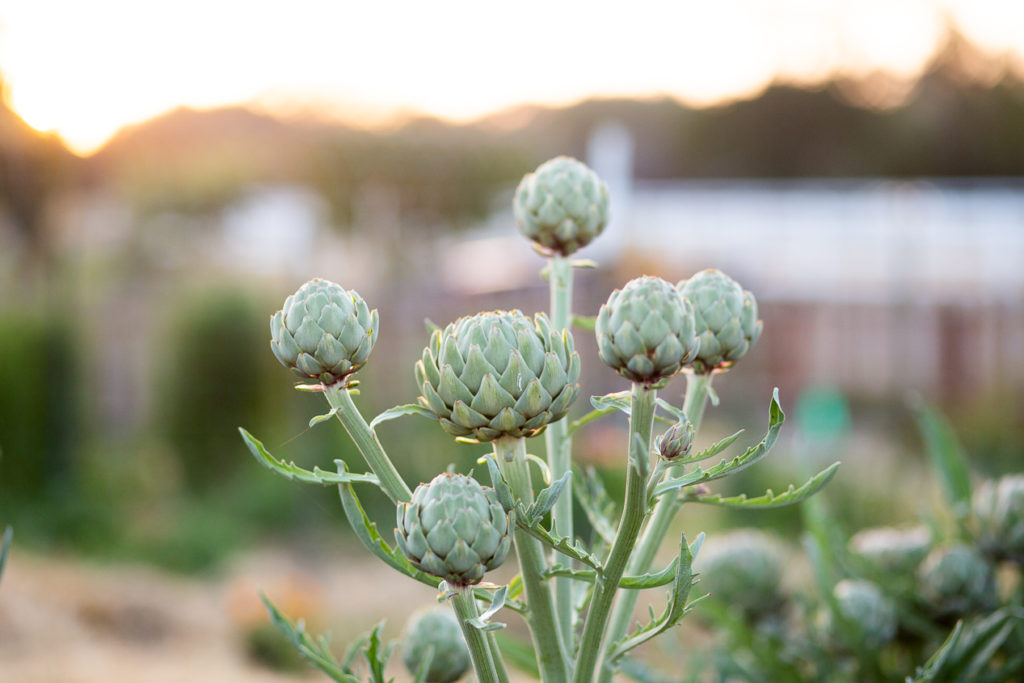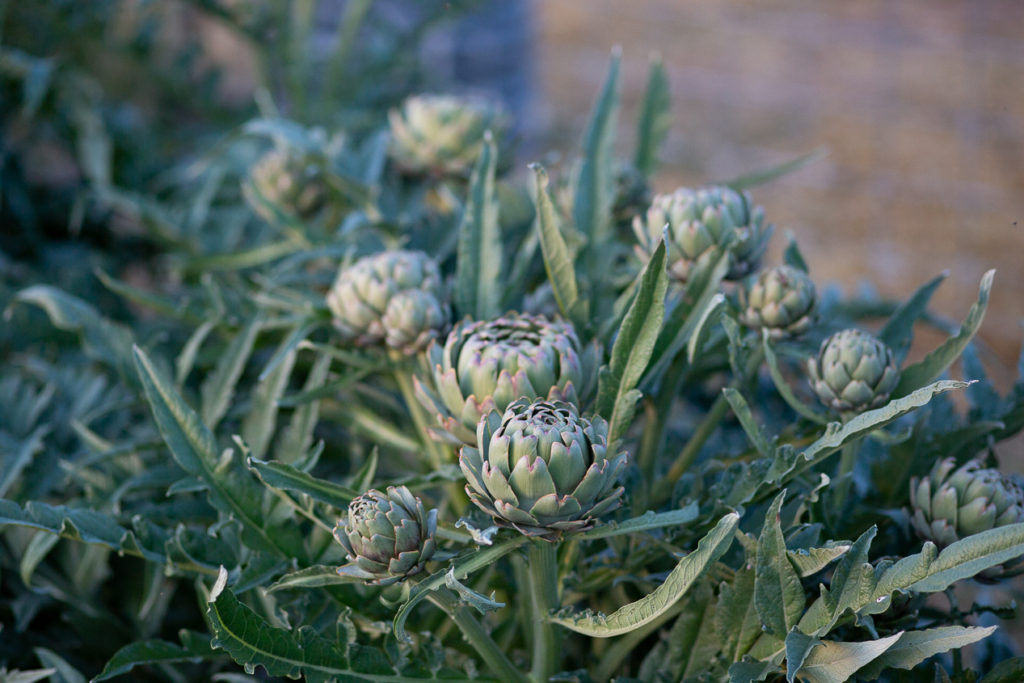Artichokes are one of the easiest to grow and most nutritious vegetables. Learn how to grow artichokes on in zone 9.

In 2015 we were moving an old chicken coop and run. After we removed all of the old fencing, we were left with this rich ally of growing space. We did a little research on what would be best in this high nitrogen area. What we found was that artichokes would be the perfect fit! Since they are fairly low maintenance, we could plant them and forget them…except for a few times a year when we are ready to harvest, fertilize, and re-mulch!
We decided to dump the contents of the lamb pen out in this ally and let it break down a bit before planting in the Spring. We let that area rest and get even richer, before in the Spring planting out brand-new artichoke seedlings.
Those same artichokes are still there…just much bigger! Every year in the Spring, they provide us with an abundant amount of organic delicious artichokes that we enjoy in a variety of ways. This guide will help you get on your way to growing artichokes on your homestead.
Artichokes Quick Glance Guide
| Plant type | Perennial |
| Origin | Africa, Italy |
| Scientific name | Cynara cardunculus |
| Other names | French artichoke, globe artichoke, green artichoke |
| Soil type | Loamy, clay, sandy, generic, well-draining |
| Soil pH | 6.0-7.5 (slightly acidic to neutral) |
| Sunlight requirement | Full Sun |
| Bloom season | Spring, summer |
| Colors | Green, yellow, purple |
| Max height | ~5 feet |
| Max width | ~6-8 feet |
| Watering requirements | Medium to low |
| Fertilizer NPK | 5-5-5 |
| Days until germination | 2-3 weeks |
| Speed of growth | Moderate |
| Plant depth | 0.5 inches (seed) |
| Plant spacing | 3-6 feet |
| Propagation | Seeds, division, root cuttings |
| Indoor plant | No |
| Outdoor plant | Yes |
| Grown in container | Yes |
| Beginner friendly | Yes |
| Care Level | Care level |
| Flowering plant | Yes |
| Uses | Culinary, stew, soup, decor, fresh cut, farming, produce |
Phew! now that we’ve had a quick glance at how to grow artichokes in zone 9, it’s time to dive deeper!

Why you should grow artichokes in zone 9
We have found that artichokes are a such a welcome part of our homestead because they so low maintenance. Zone 9 is known for its hot summers and at times dry climate, which artichokes tolerate fairly well. They also over winter here once they are established. If you are not yet convinced to add this green super food to your garden and yard. Keep reading!
Artichokes Nutritional Facts
Artichokes are an excellent source of vitamin C, fiber, and potassium! They are also high in fiber, vitamin k and folate (which is especially great for expecting mothers.)
Grow artichokes for the health benefits!
If the above nutritional facts didn’t convince you, let me put it in simpler terms. Artichokes have an entire host of health benefits like:
- Supports heart health
- May lower cholesterol levels
- Might improve liver health
- Fights the effects of aging
Artichokes are a beautiful ornamental!
Not only are they a nutritious edible, but they also are beautiful to look at. I’ll be honest, there has been some years that we didn’t harvest our entire artichoke crop because life was really busy during those years. I still loved to look at the silvery angular leaves and the beautiful artichoke buds reaching up. Then they flower and look even more incredible! Even if you do not prefer eating artichokes consider growing them as a seasonal hedge.
Artichokes are delicious!
Artichokes can be used in a variety of recipes or eaten all on their own. They usually need to be steamed or roasted at the very least. They are especially good in recipes like:
- Artichoke Dip
- Having the hearts on pizza or pasta
- Roasting the Hearts for salads
- Garlic Lemon Bay Leaf Artichokes

Most Common Varieties of Artichokes to Grow in Zone 9
- Green globe–This is by far the most common variety grown by the home gardener. It’s what we grow! The Green Globe artichoke is a perennial heirloom variety with silvery-green leaves. The flower bud, the edible part of the artichoke plant, develops on a tall stem from the center of the plant. Green Globe artichoke plants produce three to four buds, which are 2 to 5 inches in diameter. If the artichoke bud is not harvested, it will open into an attractive purple thistle-like flower.
- Siena–The oblong Siena, was of a breeding program in central Italy, has a small choke and dark wine color. Slow to mature and still grown in relatively small quantities, this small artichoke usually weighs less than a pound and has a heart tender enough to be eaten raw.
- Baby Anzio--Light red and only roughly one inch in diameter when fully grown, the purple baby anzio is a relative of the Romanesco artichoke. Like many baby artichokes, baby anzios can be cooked and eaten whole.
- Castel–This light green and round shape variety is loaded with vitamin B, potassium, calcium, and antioxidants. Have it steamed or boiled with a dip. It also helps in relieving low-blood pressure and digestive ailments.
- Fiesole--features a tulip-shaped flower with deep violet-wine colored skin. This is the most delicious of all baby artichoke varieties with intense nutty and fruity flavor with grassy tones.
- BONUS VARIETY! Jerusalem artichokes, often called “sunchokes” are native to North America and are no relation at all to artichokes. Jerusalem artichokes belong to the sunflower family. The white flesh is nutty, sweet and crunchy like chestnuts when raw. Baked in their skins, they become more like potatoes with a mild taste of artichoke hearts.
How to Grow Artichokes in zone 9
Where I live in Zone 9, we plant artichokes in the fall, and let them overwinter through our rainy season unprotected.
The plants grow through the winter, put on a big burst of growth in March and April, then flower in May. We eat the big, dense artichokes from the middle of the plant first, then harvest the abundant baby chokes that follow until mid-June. I even like to use the small artichokes in bouquets of farm fresh flowers.
In July, with the peak of summer heat coming, we cut them back. They re-sprout in August, leaf out in the fall, and grow through winter, then flower again the next Spring.
Each plant produces for 4-5 years, with the chokes getting smaller and more numerous in the later years, because they’re producing from side-branches off the main stem.
When the artichokes start getting smaller than you’d like, divide the crowns into several divisions, and transplant them into their own space. They’ll produce for several more years before you have to start again from seed or fresh seedlings.

How to harvest artichokes
Artichokes are easy to harvest so long as you have a sharp knife. Cut the artichoke 3-4 inches below the bottom of the bud slightly at an angle.
Recipes that use artichokes
- Artichoke Chicken Pesto Pizza
- Potato and Artichoke Frittata
- Kale & Artichoke Dip
Common problems with growing artichokes in zone 9
Growing artichokes in zone 9 is fairly low maintenance. There are some diseases and pests to consider for before planting yours out.
Diseases
- Root rot
- powdery mildew
- dwarf virus
- damping off
- Botrytis
Pests
- Aphids
- thrips
- leaf-miners
- gastropods
- plume moths
- caterpillars
- beetles
- weevils

How to grow artichokes in zone 9 FAQ
You may have questions about growing artichokes. Before you get started or during the process consider some frequently asked questions and explore the answers.
Is artichoke fruit or vegetable?
It is easy to see why some might question whether artichokes are fruits because artichoke plants produce flowers. However, many vegetables bloom: leeks, collard greens, lettuce, onions, garlic, and many other vegetables flower at the end of their growth period. Artichokes are vegetable plants.
What are the best artichoke companion plants?
Since artichokes require such a high amount of nutrients, they are best planted by themselves. Especially since they are fairly resistant to most pests and diseases, it isn’t as necessary. If you are wanting to know what will be okay next to them, try: cabbage, peas, radish, asparagus, sunflowers, tarragon, and some herbs. These can help complement artichoke and won’t compete for nutrients, that the artichoke require.
What to consider about growing artichokes in pots
Artichokes grow great in containers. Potted artichokes are easy to grow if you provide them with a large enough container. The plant can get quite big, and its root system is quite large. Keep in mind, that the container soil will dry out more quickly than in ground planted artichokes. You will need to water them more regularly.

When are artichokes in season?
In zone 9, artichokes are in season March through May.
Where can I find artichoke plants for sale?
Artichoke plants can be found at a local nursery, farmer’s market or even at a hardware store. Check with your gardening neighbor if you have one. If they also grow artichokes, they may have baby artichoke plants growing around the large crowns, depending on the time of year. This the seeds spread and re-plant themselves after the artichoke in bloom.
When does an artichoke in bloom?
If the artichokes go unharvested, the artichoke will bloom into a beautiful purple flower. This typically happens late spring and early summer. These blooms are highly attractive to beneficial pollinators so leave them as long as you can!
Pin it for later:

You May Also Like:
Garlic Lemon Bay Leaf Artichokes

Leave a Reply